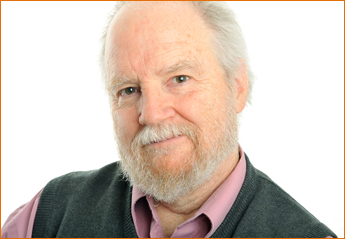
Scientific Discipline
Developmental Biology, Neuroscience
Related Links
Host Institution
Janelia Research Campus
Current Position
Dr. Truman is a group leader at the Janelia Research Campus.
Current Research
From Stem Cells to Behavior
Research
Biography
For all the revulsion the mention of their name generates, maggots embody one noble characteristic: they are the ultimate recyclers—at least when it comes to neurons. Hatched with a nervous system that permits them to do little more than feed and crawl, they transform into complex animals with sophisticated sensory systems and behaviors, such as walking and flying.
Understanding how the maggot remodels and grows the neurons needed to build a central nervous system that can coordinate such complex behaviors has brought James Truman to the Janelia Research Campus. There, he will lead a group exploring how neuronal stem cells in the maggot produce the diversity of nerve cell types found in the adult fruit fly.
"Maggots aren't very bright," Truman says. "They don't have legs, they don't have leg motor neurons. In order to metamorphose into an adult, they need to churn out neurons and stockpile them. At metamorphosis, the neurons start to sprout and seek out adult connections. The fly is a simple enough system that we should be able to figure out how this happens."
Truman's exploration of insect nervous system development began with a fascination with hormones. As a graduate student at Harvard University, he studied the role of hormones in insect molting behavior under the tutelage of Lynn Riddiford, who is now his wife. While in graduate school, Truman identified an insect neurohormone, eclosion hormone, which causes the larvae to initiate the complex behaviors needed to molt. Shedding an exoskeleton is a high-stakes proposition for the molting larvae. If they aren't successful, they die.
"Hormones are coordinating agents that are capable of mobilizing changes all over the central nervous system," he says. "Even when you look at the mature nervous system, you still see hormones directing behavior. Animals eat food when they are hungry and reproduce during certain cycles all because hormones act on their brain to indicate the animal's physiological needs."
Truman's work as an independent researcher has focused on how the larval central nervous system remodels itself into an adult nervous system, with special emphasis on neuronal pruning and programmed cell death. Recently, however, his focus has shifted to the adult-specific neurons generated during larval life that make up the bulk of the adult nervous system.
"There is a whole set of neuronal stem cells that are dormant when a maggot hatches but then start generating new neurons as the larva feeds and grows," says Truman, who retired from the biology department at the University of Washington in Seattle to join Janelia. "We just ignored them for years. But what we want to find out, on a stem cell by stem cell basis, is how they construct the adult nervous system."
Truman is concentrating on the computationally complex section of the adult fly's central nervous system that operates the wings and legs. This thoracic nervous system comprises approximately 15,000 neurons. All of those neurons are derived from 25 different stem cell lineages. Truman wants to relate circuit formation and behavior to the molecular expression patterns of each stem cell and the cells derived from it.
Each stem cell ultimately produces a long series of A and B daughter neurons. Truman is especially interested in discovering the molecular signatures specific for each of these cells because whether a cell is from the "A" or "B" lineage determines its ultimate fate in the adult.
Truman says the simplicity of the fruit fly system should allow the team to identify the gene expression patterns that determine the function of neuronal lineages relatively rapidly. Once this pattern is described for the thoracic nervous system, Truman envisions moving on to describing the insect's brain development.
Truman is eager to work with other scientists at Janelia to create a comprehensive set of fruit fly lines that will allow researchers to manipulate gene expression in all the neuronal stem cell lineages. In order to evaluate the effects of gene expression on neuronal development, he also hopes to get help from people who are skilled in analyzing the behavior of individual flies. Since his long-term goal is to understand how nervous systems have changed throughout evolution, he also plans to collaborate with the experts in comparative genomics at Janelia.
"Mammals make their neurons in a very different way from flies," says Truman. "Still, I think that there are rules in neuronal development that may be conserved through evolution."
Research Papers
Selected Research Papers



